Jesus B. Alonso-Hernandez
Identification of Hypokinetic Dysarthria Using Acoustic Analysis of Poem Recitation
Mar 18, 2022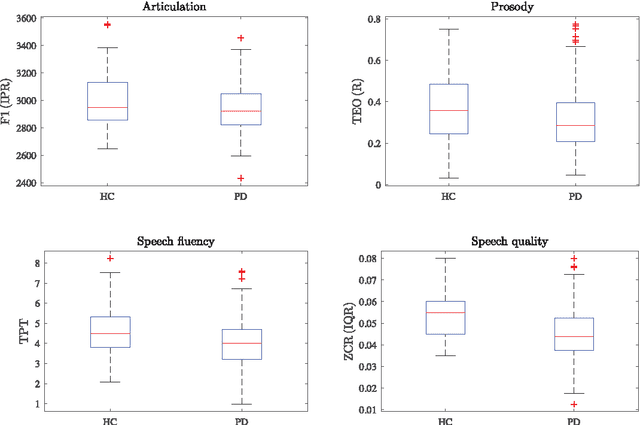

Abstract:Up to 90 % of patients with Parkinson's disease (PD) suffer from hypokinetic dysarthria (HD). In this work, we analysed the power of conventional speech features quantifying imprecise articulation, dysprosody, speech dysfluency and speech quality deterioration extracted from a specialized poem recitation task to discriminate dysarthric and healthy speech. For this purpose, 152 speakers (53 healthy speakers, 99 PD patients) were examined. Only mildly strong correlation between speech features and clinical status of the speakers was observed. In the case of univariate classification analysis, sensitivity of 62.63% (imprecise articulation), 61.62% (dysprosody), 71.72% (speech dysfluency) and 59.60% (speech quality deterioration) was achieved. Multivariate classification analysis improved the classification performance. Sensitivity of 83.42% using only two features describing imprecise articulation and speech quality deterioration in HD was achieved. We showed the promising potential of the selected speech features and especially the use of poem recitation task to quantify and identify HD in PD.
Robust and Complex Approach of Pathological Speech Signal Analysis
Mar 17, 2022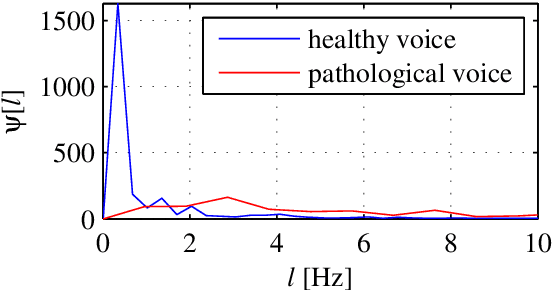


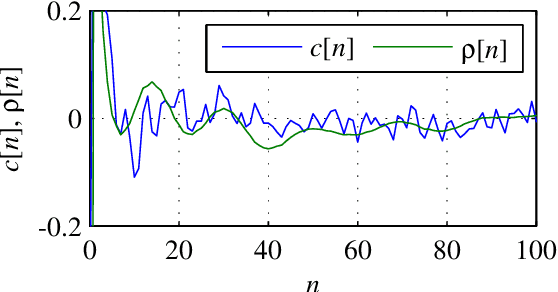
Abstract:This paper presents a study of the approaches in the state-of-the-art in the field of pathological speech signal analysis with a special focus on parametrization techniques. It provides a description of 92 speech features where some of them are already widely used in this field of science and some of them have not been tried yet (they come from different areas of speech signal processing like speech recognition or coding). As an original contribution, this work introduces 36 completely new pathological voice measures based on modulation spectra, inferior colliculus coefficients, bicepstrum, sample and approximate entropy and empirical mode decomposition. The significance of these features was tested on 3 (English, Spanish and Czech) pathological voice databases with respect to classification accuracy, sensitivity and specificity.
* 41 pages, published in Neurocomputing, Volume 167, 2015, Pages 94-111, ISSN 0925-2312
Assessing Progress of Parkinson s Disease Using Acoustic Analysis of Phonation
Mar 17, 2022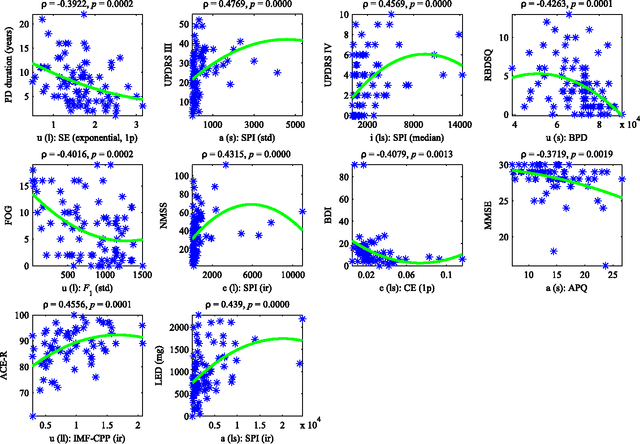
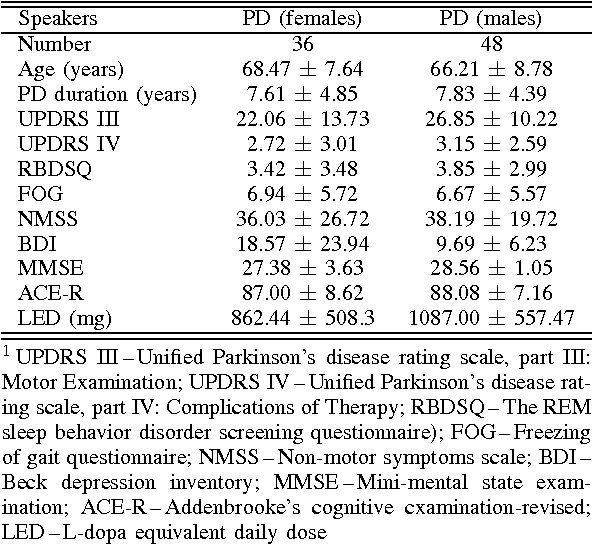
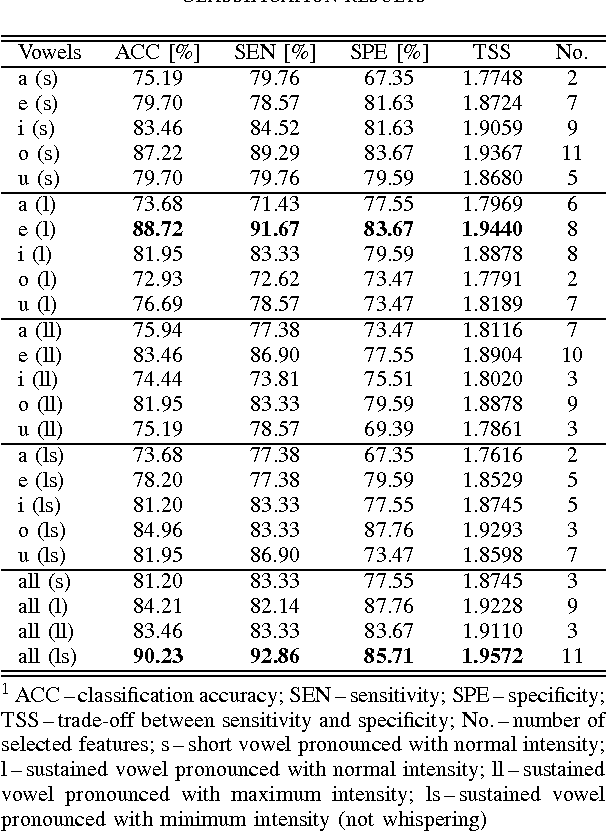
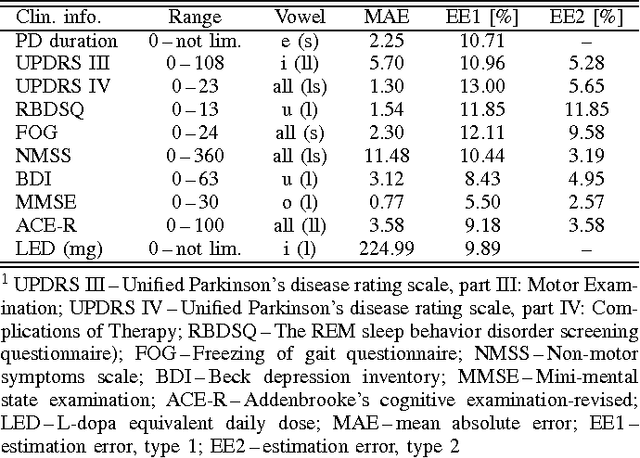
Abstract:This paper deals with a complex acoustic analysis of phonation in patients with Parkinson's disease (PD) with a special focus on estimation of disease progress that is described by 7 different clinical scales ,e. g. Unified Parkinson's disease rating scale or Beck depression inventory. The analysis is based on parametrization of 5 Czech vowels pronounced by 84 PD patients. Using classification and regression trees we estimated all clinical scores with maximal error lower or equal to 13 %. Best estimation was observed in the case of Mini-mental state examination (MAE = 0.77, estimation error 5.50 %. Finally, we proposed a binary classification based on random forests that is able to identify Parkinson's disease with sensitivity SEN = 92.86 % (SPE = 85.71 %). The parametrization process was based on extraction of 107 speech features quantifying different clinical signs of hypokinetic dysarthria present in PD.
* 8 pages published in the 4th IEEE IWOBI 2015, pp. 115-122, 10-12 June, 2015 Donostia-San Sebastian. ISBN: 978-84-606-8733-7
Towards Robust Voice Pathology Detection
Jul 13, 2019
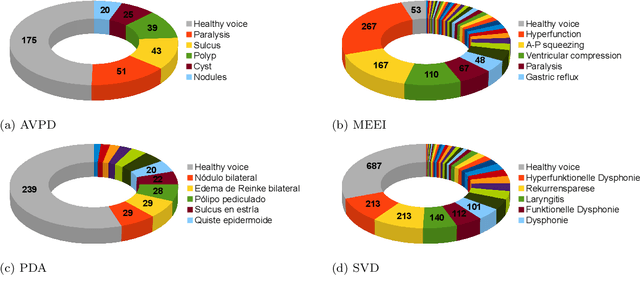
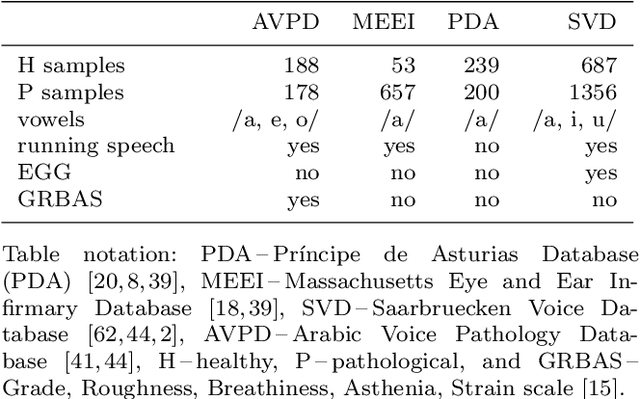
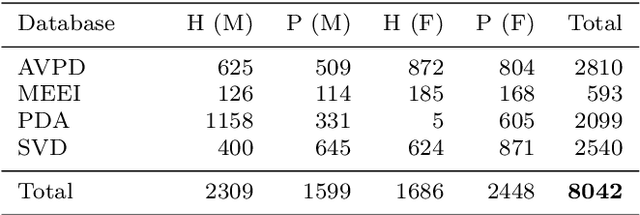
Abstract:Automatic objective non-invasive detection of pathological voice based on computerized analysis of acoustic signals can play an important role in early diagnosis, progression tracking and even effective treatment of pathological voices. In search towards such a robust voice pathology detection system we investigated 3 distinct classifiers within supervised learning and anomaly detection paradigms. We conducted a set of experiments using a variety of input data such as raw waveforms, spectrograms, mel-frequency cepstral coefficients (MFCC) and conventional acoustic (dysphonic) features (AF). In comparison with previously published works, this article is the first to utilize combination of 4 different databases comprising normophonic and pathological recordings of sustained phonation of the vowel /a/ unrestricted to a subset of vocal pathologies. Furthermore, to our best knowledge, this article is the first to explore gradient boosted trees and deep learning for this application. The following best classification performances measured by F1 score on dedicated test set were achieved: XGBoost (0.733) using AF and MFCC, DenseNet (0.621) using MFCC, and Isolation Forest (0.610) using AF. Even though these results are of exploratory character, conducted experiments do show promising potential of gradient boosting and deep learning methods to robustly detect voice pathologies.
* 11 pages, 1 figure, 10 tables. Keywords: Voice pathology detection, deep learning, gradient boosting, anomaly detection
Voice Pathology Detection Using Deep Learning: a Preliminary Study
Jul 12, 2019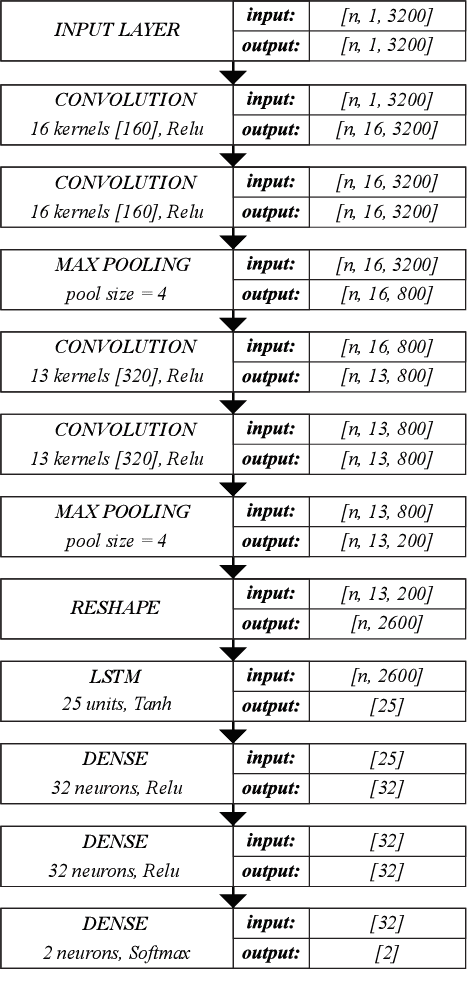



Abstract:This paper describes a preliminary investigation of Voice Pathology Detection using Deep Neural Networks (DNN). We used voice recordings of sustained vowel /a/ produced at normal pitch from German corpus Saarbruecken Voice Database (SVD). This corpus contains voice recordings and electroglottograph signals of more than 2 000 speakers. The idea behind this experiment is the use of convolutional layers in combination with recurrent Long-Short-Term-Memory (LSTM) layers on raw audio signal. Each recording was split into 64 ms Hamming windowed segments with 30 ms overlap. Our trained model achieved 71.36% accuracy with 65.04% sensitivity and 77.67% specificity on 206 validation files and 68.08% accuracy with 66.75% sensitivity and 77.89% specificity on 874 testing files. This is a promising result in favor of this approach because it is comparable to similar previously published experiment that used different methodology. Further investigation is needed to achieve the state-of-the-art results.
* 4 pages, 1 figure, 5 tables
 Add to Chrome
Add to Chrome Add to Firefox
Add to Firefox Add to Edge
Add to Edge